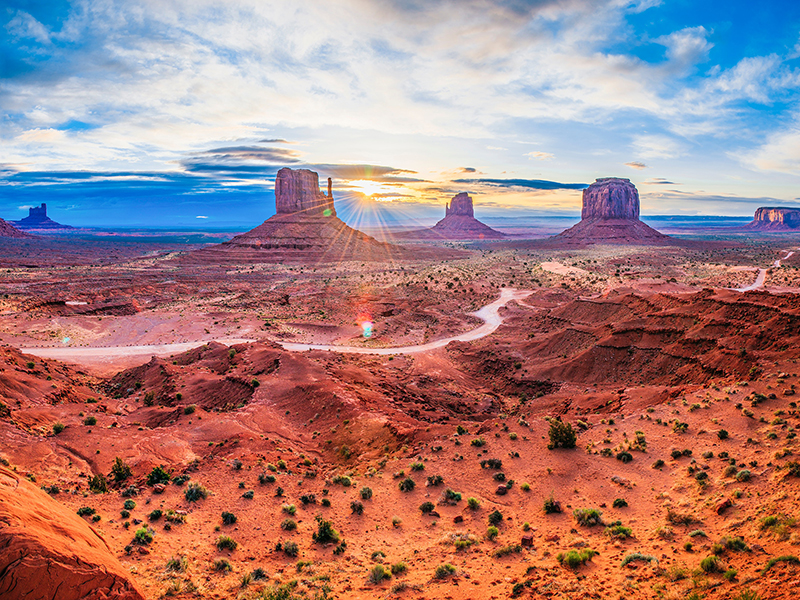By Jill “MamaBug” Frier
Most people in Phoenix venture north of the Valley for a day trip now and then. We like to visit the mountains, tall pines and cool summers of Flagstaff with trips to the Grand Canyon National Park’s South Rim and the small towns and sights to see on the way. But north of Flagstaff and the South Rim lies a vast, sparsely populated wilderness. If you’re looking for adventure on the road less travelled, here are some places you can visit north of I-40 in Arizona.
Grand Canyon National Park – North Rim
If you enjoy the majestic beauty of the Grand Canyon, but aren’t crazy about all the tourists, you should check out the North Rim of Grand Canyon National Park. The North Rim is about a four-hour drive from the South Rim and sits at over 8000 feet in elevation, which means it is closed during winter months due to harsher winter weather. With gorgeous views and an abundance of wildlife, the North Rim has just one lodge, one campground and accounts for only 10 percent of all Grand Canyon visitors.
Vermilion Cliffs National Monument
On the road to the North Rim of the Grand Canyon lies a spectacular vision of towering canyon walls. The Vermilion Cliffs National Monument is located on 294,000-acres of the Colorado Plateau, just south of Utah. This monument includes the Paria Canyon-Vermilion Cliffs Wilderness, which is home to Coyote Buttes. You may recognize this international hiking destination, which features rock formations of colorful, swirled cross-bedded sandstone – it’s home to the famously photographic “Wave” rock formation. Be sure to plan ahead and prepare for a trip into the wilderness; there is no Visitor Center or lodging, but camping is allowed in designated areas or with a backcountry permit.
Glen Canyon National Recreation Area
The Glen Canyon National Recreation Area is located on the Arizona and Utah border, at the center of the Colorado Plateau. This natural wonder encompasses over 1.25 million acres and offers visitors an array of water-based and backcountry recreation. The recreation area also protects scenic, scientific, natural, and cultural resources on Lake Powell, the Colorado River, its tributaries, and surrounding lands. The gateway to Glen Canyon and Lake Powell is the small town of Page, Arizona. This community offers a wide variety of lodging, services and recreational resources for visitors to the lake.
Grand Canyon – Parashant National Monument
The Grand Canyon National Park is not the only way to see the incredible views the Grand Canyon offers. You can travel west of the North Rim and take a rocky, two-track road in a 4×4 to the edge of the Grand Wash Cliffs, where you will find a stunning, solitary view deep into the Grand Canyon. The Grand Canyon-Parashant National Monument is a dynamic geologic environment with amazing vistas, volcanic flows and mountains on the move. The monument is incredibly remote, so plan ahead and be prepared to leave pavement, cell service, and modern conveniences behind.
Navajo National Monument
Just south of the Utah border and about an hour west of Monument Valley, you will find the Navajo National Monument. Established in 1909 to protect the remains of three large and incredibly well-preserved prehistoric pueblos, Keet Seel, Betatakin, and Inscription House, this monument represents a long cultural history of the Navajo people and their ancestors. Located on the Navajo Nation approximately nine miles from Highway 160 at the end of AZ Highway 564, the Navajo National Monument is a free park that offers a picnic area and camping facilities.
Monument Valley Tribal Park
Stunning rock formations and broad vistas welcome you to the Navajo Nation’s Monument Valley Park. The on-site location for many western movies, visitors get to see and experience one of the most majestic and photographed places on earth. Monument Valley is a vast swath of desert just south of the Utah border on the Navajo Nation, displaying graceful sandstone masterpieces that tower at heights of 400 to 1,000 feet. Highway 163 runs through Monument Valley to Utah, but travelers can stop by the Visitor Center to eat, buy Navajo arts and crafts, and pay to travel through a specially designated area of the park.
The far northern part of Arizona is a vast wilderness that covers hundreds of miles on both paved and unpaved roads. If you crave the solitude of nature and a journey off the beaten path, a trip to this part of Arizona is for you. Be sure to check Ladybugs Blog (www.LadybugsBlog.com) for information about other fantastic places to visit in the great state of Arizona.





